Catégorie: "Painting"
Pages: << 1 2 3 ...4 ...5 6 7 ...8 9 >>
23.09.16
A collage speaks to me
Warning: "continue" targeting switch is equivalent to "break". Did you mean to use "continue 2"? in /home/bstep754/public_html/blog/inc/plugins/model/_plugins_admin.class.php on line 1467
This year, I feel that I do nothing else than collage. At the rate of two a day, I do not have much time to do anything else. Collages accumulate to the point that I have to find new storage space. The positive in this is that I have to make some order, the negative is that I wonder what this amount of collages will become later. I still don’t achieve the supreme detachment taught by the wise, but I have to do something because I don’t want to leave with this question in mind.
What good is all this? Why this frenzy?
The simplest explanation is this: as I had to work for a living, I catch up now.
But that’s not satisfying. There is something else. Maybe my collage can tell me that. Let's take a closer look:
- Dear collage 482/16 humorously titled "Promettez"*, what is the secret of my obsession to assemble bits of images?
- You got a gift, you have to make it grow.
- Okay, but at this rate, is it necessary?
- I think there are many questions that are running through your head. This seems to be a way to view them.
- You think of M’s cancer?
- Yes, among others. And also of your own mortality, your new physical impairments, such as very short dizziness, your soreness after gardening, your skin becoming so fragile that you wear still the mark of January’s catheter, not to mention light tone tinnitus. Do you want me to quote some more?
- No, thanks, that's enough for now. You mean I feel my death coming closer and that this moves me inside?
- Yes, of course. Moreover, you wonder how to express your relationship to the outside world, how define yourself by it. You're probably relatively unsuitable, you have always preferred dream to reality.
- If I understand you well, I take refuge in my daydreams?
- Yes that's right. But you have the right to rest a little. Fear not, your imagination will not dry up (it's over).
- I thank you and I will try to do as you think.
· = Prométhée in French = Prometheus
Cette année, j’ai l’impression de ne faire que du collage. Au rythme de 2 par jour, il ne me reste pas beaucoup de temps pour faire autre chose. Et les collages s’accumulent, au point que je dois trouver de nouveaux espaces de stockage. Le positif dans cela, c’est que je suis obligé de faire de l’ordre, le négatif, c’est que je me demande ce que cette quantité de collages va devenir. Je n’arrive pas encore au suprême détachement enseigné par les sages, mais il faudra que je m’y mette pour ne pas partir avec cette question à l’esprit.
A quoi bon tout cela ? Pourquoi cette frénésie ?
L’explication la plus simple est la suivante : comme j’ai dû travailler pour gagner ma vie, je me rattrape maintenant.
Mais j’ai de la peine à m’en satisfaire. Il y a autre chose. Peut-être que mon collage peut me renseigner là-dessus. Voyons cela de plus près :
- Cher collage 482/16 intitulée humoristiquement « Promettez », quel est donc le secret de mon obsession à assembler des bouts d’images ?
- Tu as reçu un don, tu dois le faire fructifier.
- D’accord, mais à ce rythme, est-ce nécessaire ?
- Je crois qu’il y a beaucoup de questions qui se bousculent dans ta tête. Cela semble être une manière de les visualiser.
- Tu penses au cancer de M. ?
- Oui, entre autres. Et aussi à ta propre mortalité, à tes nouvelles déficiences physiques, comme par exemple des vertiges très brefs, tes courbatures après le jardinage, ta peau devenue si fragile que tu portes encore la marque du cathéter de janvier, sans parler de ton léger acouphène. Tu veux que je t’en cite d’autres ?
- Non, de grâce, cela me suffit pour le moment. Tu veux dire que je sens ma mort se rapprocher et que cela me remue intérieurement ?
- Oui, bien sûr. Par ailleurs, tu te demandes comment exprimer ton rapport au monde extérieur, comment tu te définis par lui. Tu es sans doute relativement inadapté, tu as toujours préféré le rêve à la réalité.
- Si je te comprends bien, je me réfugie dans mes rêves éveillés ?
- Oui, c’est cela. Mais tu as le droit de te reposer un peu. N’aie pas peur, ton imagination ne va pas se tarir (c’est du passé).
- Je te remercie et je tâcherai de faire selon ton avis.
Form is loading...
01.09.16
A collaged kiss
The collage is like a kiss: the meeting of two foreign elements that must, however, have affinities. It is thus not the die-cuts which make a collage, but their assembly. This could be tedious and not very creative, like a rhyme like "night - right," but it is to create surprises, so the unexpected. It is not for nothing, it seems, that Herta Müller, the great writer of German language - agglutinative language par excellence, thus "agglutinative" - whose compound words are very surprising, also creates collages. To do this, simply combine the elements as the famous surrealist definition of the chance encounter on a dissecting-table of a sewing-machine and an umbrella, while seeking an overall sense of the resulting image, in order to avoid scattering the meanings.
Collage 439/16 is typical for my current research to create a "cubist" space where different elements have their own space and dimension, while remaining interconnected. There is no logical justification for the passage between the relatively flat brown background and space dug behind the robot. The separation is clear, arbitrary, like a spontaneous cut of scissors. Yet, the image seems likely.
No 435/16 is the most extreme in this regard, as it opposes color and black and white, clear and fuzzy, full and empty, untouched and open. No. 408/16 marks a significant step in this research.
To return to the kiss (no. 420/16), it sums up my artistic concerns of the moment. Don’t we say in French that one "embraces" a career? That's how I see my relationship with the collage anyway.
Le collage, c’est comme un baiser : la rencontre de deux éléments étrangers qui doivent cependant présenter des affinités. Ce n’est donc pas le découpage des formes qui fait le collage, mais leur assemblage. Cela pourrait être fastidieux et peu créatif, à la manière d’une rime du genre « amour – toujours », mais il s’agit de créer des surprises, donc de l’inattendu. Ce n’est pas pour rien, il me semble, que Herta Müller, la grande auteure de langue allemande – langue agglutinante par excellence, donc « colleuse » - dont les mots composés sont surprenants, crée aussi des collages. Pour cela, il suffit d’associer les éléments - selon la célèbre définition surréaliste de la rencontre fortuite sur une table de dissection d' une machine à coudre et d' un parapluie - , tout en cherchant un sens global à l’image résultante, pour ne pas éparpiller les significations.
Le collage 439/16 (French robot) est typique de mon actuelle recherche qui vise à créer un espace « cubiste » où les différents éléments ont leur propre dimension et espace, tout en restant interconnectés. Il n’y a pas de justification logique du passage entre le fond brun relativement plat et l’espace creusé derrière le robot. La séparation est nette, arbitraire, comme un coup de ciseaux spontané. Et pourtant, l’image me paraît vraisemblable.
Le no 435/16 (Getting enhanced) est plus extrême à cet égard, vu qu’il oppose couleur et noir et blanc, net et flou, plein et creux, intact et ouvert. Le no. 408/16 (Open mind) marque une étape dans cette recherche.
Pour revenir au baiser (no. 420/16, Royal kiss), il résume bien mes préoccupations artistiques du moment. Ne dit-on pas en français qu’on « embrasse » une carrière ? C’est comme cela que je vois ma relation avec le collage en tout cas.
You must be logged in to see the comments. Log in now!
Form is loading...
10.08.16
Black milk
Patchwork
Must we always explain our creations? I have little time or inclination to do so, except when it becomes urgent.
Here is a confused looking collage at first view because it uses Dali's technique of hallucination as a double view. In this image, a peaceful family is seen in the lower part which extends to the oversized character of the top. It is a Black and whose crying disturbs this idyllic scene. It is obviously an evocation of slavery: Whites are idle, they enjoy their comfortable situation. With one exception: the milking of the cow in the lower left corner, referring to the serfs?
By adopting a different point of view, it could be the nostalgic contemplation of a mythical past (the good old days), where man was supposed to live in harmony with the earth. It is true that many paintings of Poussin, Constable or the Impressionists have cultivated this fable.
What I consciously expressed in this picture is the ratio between stability and instability. The figure of the Black appeared to me towards the end, when I asked myself what was missing in the picture. And the head in profile, like that of the man sitting, could then be the close up of this man whose head is only partially visible, as if hovering above this idyll in the manner of a spirit. As for the milk, it makes me to think of Paul Celan: "Black milk of dawn ..." in his Death Fuge. Et in Arcadia ego ... to stay with Poussin.
Faut-il toujours expliquer ses créations ? Je n'en ai guère le temps ni l'envie, sauf quand cela s'impose à moi.
Voici donc un collage à priori confus car empruntant la technique dalinienne de l'hallucination sous forme de double vue. Dans cette image, on voit une paisible famille dans la partie inférieure dont certaines parties prolongent le personnage surdimensionné de la partie supérieure. C'est un Noir qui pleure et qui perturbe cette scène idyllique. Il s'agit évidemment d'une évocation de l'esclavage : les Blancs sont oisifs, ils jouissent de leur situation confortable. A une exception près : la traite de la vache dans le coin inférieur gauche, allusion aux serfs ?
En adoptant un autre point de vue, il pourrait s'agir de la contemplation nostalgique d'un passé mythifié (le bon vieux temps), où l'homme était censé vivre en harmonie avec la terre. Il est vrai que bien des peintures, de Poussin à Constable, voire les Impressionnistes ont cultivé cette fable.
Ce que j'ai consciemment exprimé dans cette image, c'est le rapport entre stabilité et instabilité. La figure du Noir ne m'est apparue que vers la fin, lorsque je me suis demandé ce qui manquait. Et cette tête, de profil, comme celle de l'homme assis, pourrait alors être le gros plan sur cet homme dont la tête n'est que partiellement visible, comme s'il planait au-dessus de cette idylle à la manière d'un esprit. Quant au lait, il me fait penser au vers de Paul Celan : « Lait noir de l'aube... » dans sa Fuge de mort. Et in Arcadia ego... pour rester avec Poussin.
You must be logged in to see the comments. Log in now!
Form is loading...
09.08.16
In the garden of art
I feel like a gardener who looks after the tradition of painting and without chemistry! And sometimes weed insinuate themselves among the flowers – for the better!
So this collage based on a Van Gogh painting. The gardener is very old because he embodies the long history of painting and this before an impressionistic background. Behind him, a Malevich peasant stands as a reminder of the quarrel between figuration and abstraction, the latter pretending to be progressive, consistent with modernity and revolution. There have been anathema against figurative art. This art has been banned from exhibitions in the 50-60ies, but fortunately this wall of oppression has not kept! Because what counts in my opinion, is the joy of creating freely and to circumvent rules and dogmas. Accept them means to restrict oneself. It is like obeying a diffuse authority consisting of some "experts". I doubt that submission is an artistic value in any field of art . To me it looks like a French garden, made without fantasy and giving the impression of sterility. And it hardly calls for the enjoyment of the premises, evidenced by the rooms devoted to conceptual art!
In my garden I'm trying to experiment with new associations while drawing inspiration from past successes and inviting the visitor to a fun and rewarding walk. Besides, my gardener turns both to the past and the future of art.
Je me sens comme un jardinier qui soigne la tradition de la peinture et cela sans chimie ! Et il arrive que de mauvaises herbes s'insinuent parmi les fleurs – tant mieux !
Ainsi ce collage parti d'un tableau de Van Gogh. Ce jardinier est très vieux, car il incarne la longue histoire de la peinture et ce devant un fond impressionniste. Derrière lui, une paysanne de Malevitch comme rappel de la querelle entre figuration et abstraction, cette dernière se voulant progressiste, en accord avec la modernité et la révolution. Il y a eu des anathèmes contre l'art figuratif. Cet art a été mis au ban des expositions durant les années 50-60, mais heureusement, cette chape de plomb n'a pas tenu ! Car ce qui compte, à mon avis, c'est la joie de créer en toute liberté et de contourner les règles, les dogmes. Les accepter, c'est se restreindre. C'est obéir à une autorité diffuse composée de quelques « experts ». Je doute fort que la soumission soit une valeur artistique dans quelque domaine de l'art que ce soit. Pour moi, cela ressemblerait à un jardin à la française, fait sans fantaisie et donnant l'impression de stérilité. Et cela n'invite guère à la jouissance des lieux, en témoignent les salles consacrées à l'art conceptuel !
Dans mon jardin à moi, j'essaie d'expérimenter de nouvelles associations tout en m'inspirant des réussites passées et en invitant le visiteur à une promenade ludique et enrichissante. Du reste, mon jardinier est tourné à la fois vers le passé et vers le futur de l’art.
You must be logged in to see the comments. Log in now!
Form is loading...
18.06.16
On death
No, my art will not please to enthuse the crowds. This takes away the desire to always create new experiences for the public. My joy to experience is stronger than all that.
Thus the no. 290. Starting with a mummified saint, I had the idea to paste a huge hand holding a sprig of wheat. Then I played with the idea of entering a woman's leg in this hand, but without the visual effect that satisfies me. It is by seeing by chance a picture of nuns that I took the magazine to fall on the image I needed. I naturally thought of my stay in Oberstdorf/Bavaria in 1946, a children's home run by religious Dutch Protestant nuns, and my recent stay at the Geneva hospital. Moreover, I thought of a friend, P., whose health is so desperate that I evoked his death in myself. And finally, this image also reminds my brother, who died last December and who, during the various manipulations done by other persons, threw me mocking looks like the death in this collage. There the gesture of the nun seems positive, in contrast to my own experiences. It is here only a removing of dust or putting a glaze as if it were a good cake. The dead is half hidden by the woman sending his amused gaze at the audience. That reconciles me a bit with the idea of inevitable death - that of my family like mine: I have already exceeded my 75 years of almost five months and I'm at a race against time to build my work.
Another aspect of this concern is in the No. 281, which provides a tranquil and spiritual image of death. It is the passage that I wanted to express, but without melodrama, in a very sober way, thinking of the Buddhist masters, of transformation, although personally I am no believer. It is a soothing and comforting representation that masks the violence of death.
Non, mon art ne plaira pas au point d’enthousiasmer les foules. Cela m’enlève le souci de créer toujours de nouvelles sensations pour le public. Ma joie d’expérimenter est plus forte que tout cela.
Ainsi le no. 290. Parti d’un saint momifié, j’ai eu l’idée de le munir d’une immense main tenant un brin de blé. J’ai ensuite joué avec l’idée de faire saisir une jambe de femme par cette main, mais sans effet visuel qui me satisfasse. C’est en voyant par hasard une photo de bonnes sœurs que j’ai saisi le magazine pour tomber enfin sur l’image qu’il me fallait. J’ai évidemment pensé à mon séjour à Oberstdorf (Bavière) en 1946, home pour enfants tenu par des religieuses protestantes hollandaises, ainsi qu’à mon séjour récent à l’hôpital de Genève. Par ailleurs, j’ai pensé à un ami, P., dont l’état de santé est si désespéré que j’ai évoqué sa mort en moi-même. Et enfin, cette image évoque aussi mon frère, décédé en décembre dernier et qui, pendant les différentes manipulations de tierces personnes, me lançait des regards moqueurs comme le mort dans ce collage. Là, le geste de la religieuse me semble positif, contrairement à mes propres expériences. Il n’est ici qu’un dépoussiérage voire un glaçage comme s’il s’agissait d’une bonne brioche. Le mort étant à moitié caché par la femme envoie son regard amusé au spectateur. Voilà qui me réconcilie un peu avec l’idée de la mort inéluctable – celle de mes proches comme la mienne : j’ai déjà dépassé mes 75 ans de presque 5 mois et je fais une course contre la montre pour bâtir mon œuvre.
Un autre aspect de cette préoccupation se trouve dans le no 281, qui donne une image tranquille et plus spirituelle de la mort. C’est le passage que j’ai voulu exprimer, mais sans mélodrame, de manière très sobre, en pensant aux maîtres bouddhistes, à la transformation, même si personnellement, je n’y crois pas. C’est une représentation apaisante et consolante qui masque la violence du décès.
You must be logged in to see the comments. Log in now!
Form is loading...
03.06.16
On collage/Sur le collage
This collage is an ironic illustration of my work. It takes into account only one aspect, cutting out pictures, dismember them. It is indeed quite sadistic, at least in appearance. This is the first step of an assemblage. But in fact, it is precisely the assembly that makes the image, not its destruction. The viewer first sees the motley aspect, an effect that is visible in any badly or randomly arranged collage. It would of course be nice to hide the junctures in order to obtain a unified picture, a traditional image. So there are two extremes: the disjointed picture or the unified image. What to do to escape this dilemma? Personally, I work on the junction which wants to be it in a literal sense, which unifies while showing the radical otherness of each piece put together. Why this research? I think in my first collages I was looking for a feeling, a laugh at a joke, to make my own movies. Now I am confronted with the legacy of the art, especially in painting. Probably because this legacy seems museumified and that it doesn’t inspire any more. The other day in my garden, I said to myself that my wife knew from where she came from, what piece of land, she kept its smell engraved in her. Not me, probably because my hometown was partially erased during the war and we had to go to the countryside, to stay at a peasant’s home with our nanny, my parents with their friends in their property. My only place to me is my name, my origins, not even my mother tongue. I am, that's all, I am not FROM… Thus in art, my origin, that is my work. That's why I work so hard and with such fury. When I imagine that I had to put it in the background during my so-called active life! Now I am at work for almost 11 wonderful years and I was able to regain a foothold in my original garden: my desk.
Ce collage est une illustration ironique de mon travail. Il ne prend en compte qu'un aspect, le fait de découper des images, de les démembrer. C'est en effet assez sadique, du moins en apparence. Il s'agit de la 1e étape d'un montage. Mais en fait, c'est justement l'assemblage qui fait l'image, pas sa destruction. Le spectateur ne voit d'abord que l'aspect hétéroclite, un effet que suscite tout collage mal agencé. Il serait bien entendu tentant de masquer les jointures pour obtenir une image unifiée, un tableau traditionnel. Il y a donc deux extrêmes : l'image désarticulée ou l'image unifiée. Que faire pour échapper à ce dilemme? Personnellement, je travaille sur la jonction qui se veut telle au sens littéral du mot, elle unifie tout en montrant l’altérité radicale de chacun des morceaux joints. Pourquoi cette recherche? Je crois que dans mes premiers collages je recherchais une sensation, un rire devant un gag, bref à me faire mon propre cinéma. Maintenant, je me confronte à l’héritage de l’art, notamment à la peinture. Sans doute parce que cet héritage me semble muséifié et qu’il n’inspire plus. L’autre jour, dans mon jardin, je me disais que ma femme savait d’ où elle venait, de quel bout de terre, qu’elle en gardait l’odeur gravée en elle. Moi pas, sans doute parce que ma ville natale a été en partie rasée pendant la guerre et qu'on a dû aller à la campagne, nous loger chez un paysan avec notre nounou, les parents chez leurs amis dans leur propriété. Mon seul lieu à moi, c’est mon prénom, mes origines, même pas ma langue maternelle. Je suis, c’est tout, pas je suis DE... Ainsi, en art, mon origine, c’est l’œuvre. Voilà pourquoi j'y tiens tant et avec un tel acharnement. Dire que j'ai dû mettre cela au second plan durant ma vie soi-disant active. Maintenant je suis à pied d'œuvre depuis bientôt 11 belles années ou j'ai pu reprendre pied dans mon jardin des origines : ma table de travail.
You must be logged in to see the comments. Log in now!
Form is loading...
16.04.16
WATER
It's a strange picture. It puzzles me. The character seems to throw up a water stream in which we distinguish a body. But one can also think that the water comes from the mouthpiece of an old telephone. Flood of words? And this water feeds a pebble beach where big waves washing ashore. On the wall to the right, the image of a woman whose arm is beyond the frame and holding a bag. The face of the main character consists of a part of an old painting by Caravaggio.
I must say that during all these days, I am immersed in the biography of Kafka and what impresses me is the number of letters and diary entries that he wrote every day - an endless flow of words, interrupted by empty periods. In writing the preceding sentence, I suddenly realize that since my abandonment of golf, the image stream is flowing stronger than ever. This is relevant because when I was making it, I thought of a creator, or even the Creator. This could be me.
The woman in the frame is probably a condensation of many women, but I think it holds papers, solid matter compared to this waterfall. From its image status she becomes concrete. Is it not the contribution, among others, of D.? Another option would be the image of the hero of Kaka’s Metamorphosis room.
As for the surfer, he could be another avatar of the artist who remains on the water, at the risk of falling or even drown.
Despite these explanations, the meaning of the image escapes me. And I like that.
C’est une drôle d’image. Elle constitue une énigme pour moi-même. Le personnage semble vomir un flot d’eau dans lequel on distingue un corps. Mais on peut également penser que l’eau provient de l’écouteur d’un téléphone à l’ancienne. Flot de mots ? Et cette eau nourrit une plage à galet où semblent s’échouer de grosses vagues. Sur le mur, à droite, l’image d’une femme dont le bras dépasse le cadre et qui tient une pochette. Le visage du personnage principal est constitué d’une partie d’une peinture ancienne, ici du Caravage.
Je dois dire que pendant tous ces jours, je suis plongé dans la biographie de Kafka et ce qui m’impressionne c’est le nombre de lettres et de notes de journal qu’il a écrit jour après jour – un flot incessant de mots, interrompu par des périodes de vide. En écrivant la phrase qui précède, je réalise soudain que, depuis mon abandon du golf, le flot d’images coule plus fort que jamais. C’est pertinent, car au moment de le faire, j’ai pensé à un créateur, voire au créateur tout court. Cela pourrait donc être moi.
La femme dans le cadre est sans doute une condensation de plusieurs femmes, mais je pense qu’elle tient des papiers, du solide par rapport à cette chute d’eau. De son statut d’image elle devient concrète. N’est-ce pas l’apport, parmi tant d’autres, de D. ? Une autre piste serait l’image dans la chambre du héros de la Métamorphose.
Quant au surfer, c’est encore un avatar de l’artiste qui se maintient sur l’eau, au risque de tomber ou même de s’y noyer.
Malgré toutes ces explications, le sens de l’image m’échappe. Et cela me plaît.
You must be logged in to see the comments. Log in now!
Form is loading...
04.03.16
Flesh & bones
What amuses me is to jump from one style to another. After a pop collage, here I am in surrealism, which does not happen often. No matter actually, as long as I can do my collisions. So what's happening? I think it’s about passage here. The body exhibits its bones, but it is not dead. Instead, it lives: it moves, it metamorphoses and even separates into several entities one of which flies away, the other remains there staring at me with its innocent look. I do not know if I managed to link the different elements as I saw them in my head, but there are also ruptures since the flesh seems to want to free itself of the bones to be able to float in space instead of forming a Siberian ossuary. That’s collage: the shock of disparate elements that make forget this fact by their interlinkage. The resulting confusion forces us to think the improbable assembly.
I would also say that behind the image there are others and others: here, the child covers a woman. It's like behind every work of art, there are others, the woman is painted by Goya, there are reminiscences of Dali without a specific citation, of course. And if I start to look, I also think of Max Ernst that I always liked.
And is it not a fusion between the child and its mother, a dream broken since a long time, but probably still operating? This mother that rests in the cemetery, while I still look for my fate in art.
Ce qui m’amuse, c’est de sauter d’un style à l’autre. Après avoir fait un collage pop, me voici dans le surréalisme, ce qui ne m’arrive pas souvent. Peu importe en fait, pourvu que je puisse faire mes télescopages. Alors que se passe-t-il ? Je crois qu’il s’agit de passage ici. Le corps expose ses os, mais il n’est pas mort. Au contraire, il vit : il bouge, il se métamorphose et même se sépare en plusieurs entités dont l’une s’envole alors que l’autre reste là à me fixer de son regard candide. Je ne sais pas si j’ai réussi à lier les différents éléments comme je les voyais dans ma tête, mais ici, il s’agit aussi de ruptures puisque la chair semble vouloir s’émanciper des os pour pouvoir flotter dans l’espace au lieu de former un ossuaire sibérien. C’est bien cela le collage : des chocs entre des éléments disparates qui font oublier ce fait par leur imbrication. Le trouble qui en résulte oblige à penser l’assemblage invraisemblable.
Je dirais également que derrière une image il y en a d’autres et d’autres encore : ici, l’enfant recouvre une femme. C’est comme derrière toute œuvre d’art, il y en a d’autres, la femme est peinte par Goya, il y a des réminiscences de Dali sans citation précise, bien sûr. Et si je me mets à chercher, je pense aussi à Max Ernst que j’ai toujours beaucoup aimé.
Et ne s’agit-il pas aussi d’une fusion entre l’enfant et sa mère, un rêve cassé depuis longtemps, mais sans doute toujours opérant ? Cette mère qui repose au cimetière, alors que moi je cherche encore mon devenir dans l’art.
You must be logged in to see the comments. Log in now!
Form is loading...
03.01.16
Brain and body
For some time now , it no longer obeys me immediately. Either it does not respond at all, or it will pause before reacting. Like the other day when I tried to jump over a concrete wall. I told it: "Lift your left leg, then the right" and ... nothing. It crashed against the concrete surface. But this act of insubordination shook it because it lost its blood in flows and the nasal bones were broken. Good! This will make it think twice.
At times it sends me signals that I cannot decipher: a continuous low hissing sound, always at the same height. Could it only shut up! Or could it do what I ask it for. If it no longer obeyed me, if I was just in my head, I would lose mine, of course! Because imagine without it, what a disaster! I would stay entirely to its mercy. If it wanted to take me somewhere, I could not oppose or approve its choice. And if, horrible thought, it decided to go on strike - partial or total - I’d have to turn in circles in my mind. About a partial strike: my hands, faithful servants until recently, begin to tremble from time to time, and my eyes water at every breeze, not to mention my hair which begins to draw white clover leaves on my head, a few millimeters from me! What an affront! Fortunately I am cut short by a hairdresser whose hands do not shake, phew!
It's not that I have not tried to watch it, the bugger, but it makes its own. And I am helpless, like a jealous without his beloved whose slightest absence he cannot bear.
What can I do? Nothing, I guess as it has the spirit of contradiction....... As I do!
Depuis quelque temps, il ne m’obéit plus au doigt et à l’œil. Soit il ne répond plus du tout, soit il marque une pause avant de réagir. Comme l’autre jour, quand j’ai voulu enjamber un muret en béton. Je lui ai dit: « Lève la jambe gauche, puis la droite » et … rien. Il s’est écrasé le visage contre le béton. Mais cet acte d’insubordination l’a secoué, car il a perdu son sang à flots et ses os propres du nez se sont brisés. Tant mieux ! Cela le fera réfléchir.
Par moments, il m’envoie des signaux que je n’arrive pas à déchiffrer : un faible sifflement continu, toujours à la même hauteur. Qu’il se taise donc enfin ! Ou qu’il fasse ce que je lui demande. Car s’il ne s’exécutait plus, s’il n’en faisait plus qu’à sa tête, je perdrais la mienne, pardi ! Car m’imaginer sans lui, quel désastre ! Je resterais entièrement à sa merci. S’il voulait m’emmener quelque part, je ne pourrais pas m’y opposer, voire approuver son choix. Et si, pensée horrible, il se décidait à faire grève – partielle ou totale – il ne me resterait plus qu’à tourner en rond en esprit. A propos de grève partielle : voilà que mes mains, servantes fidèles jusqu’il y a peu, se mettent à trembler de temps à autre, et mes yeux larmoient à chaque courant d’air, sans parler de mes cheveux qui se mettent à dessiner des feuilles de trèfle blanches sur ma tête, à quelques millimètres de moi ! Quel affront ! Heureusement que je les fais couper court par une coiffeuse dont les mains ne tremblent pas, ouf !
Ce n’est pas que je n’ai pas tenté de le surveiller, le bougre, mais il fait des siennes. Et je suis désemparé, comme un jaloux sans son être aimé dont il ne supporte pas la moindre absence.
Que faire ? Rien sans doute puisqu’il a l’esprit de contradiction……. Comme moi d’ailleurs !
You must be logged in to see the comments. Log in now!
Form is loading...
07.10.15
A GIF animation
These days I'm interested in fleeting images: animated GIFs.
I must say that at first it did not interest me; it is in doing that I saw the potential of this technique. Basically, I want to keep it simple, drawing inspiration from old books for children in which scenes change when pulling strips or old cartoons seen during my childhood. It is to the face that I naturally turned: what is more animated or easy to animate than a facial muscle?
And when we focus on the face, one inevitably falls on the largest experimenter- puppeteer of art: Picasso. I must say that I have, in the past, already made a series of collages from his paintings, but this was to question a work to recompose it, in short to make it my own. Here, Picasso is just a starting point, with some happy "rhymes", like the clock needle with the tears of weeping woman and a transformation of fingers into knife blades. What differentiates my collage - animated or not – here collage is the interpellation of the spectator. That is why I am more expressionistic. This need of interpellation is fundamental to me and probably the animated picture even better scotches the viewer.
Une animation GIF
Ces jours je m’intéresse aux images fugitives : des GIFs animés.
Je dois dire qu’au début cela n’intéressait guère, c’est en faisant que j’ai vu le potentiel de cette technique. Par principe, je veux rester simple, en m’inspirant de vieux livres pour enfant où les scènes se changent quand on tire des languettes ou des premiers films d’animation vus pendant mon enfance. C’est donc vers le visage que je me suis naturellement tourné : quoi de plus animé ou facile à animer qu’un muscle facial?
Et quand on s’intéresse au visage, on tombe forcément sur le plus grand expérimenteur- marionnettiste de l’art : Picasso. Il faut dire que j’ai, dans le passé, déjà fait une série de collages à partir de ses peintures, mais il s’agissait là de questionner une œuvre, de la recomposer, bref de me l’approprier. Ici, le Picasso ne me sert que de point de départ, avec quelques « rimes » heureuses, comme l’aiguille du cadran avec les larmes de la femme en pleurs et une transformation de doigt en lames de couteau. Ce qui différencie mon collage – animé ou fixe de ce tableau, c’est l’interpellation du spectateur. C’est en cela que je suis plus expressionniste. Ce besoin d’interpellation est fondamental chez moi et sans doute l’image animée permet de fixer encore mieux le regard du spectateur.
You must be logged in to see the comments. Log in now!
Form is loading...
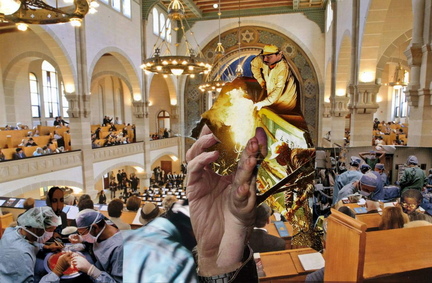
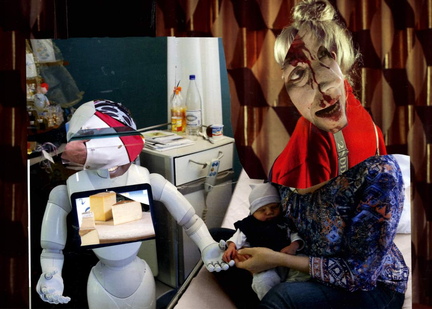
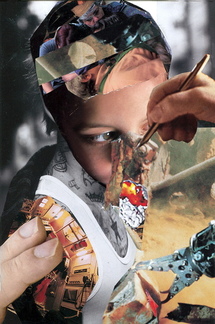
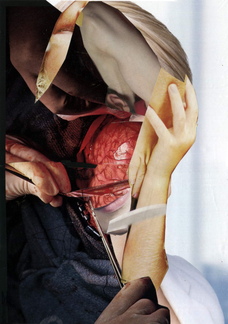
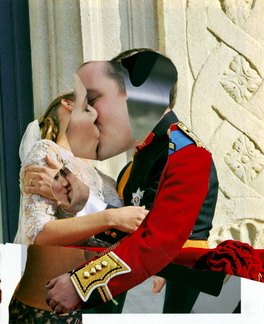
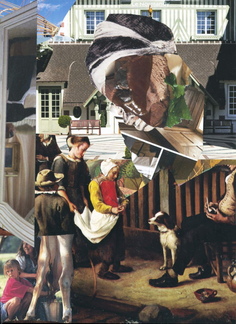
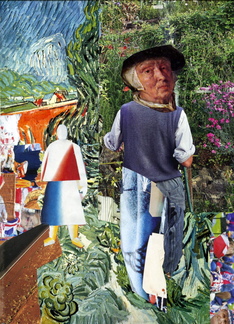
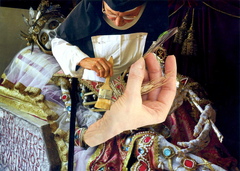
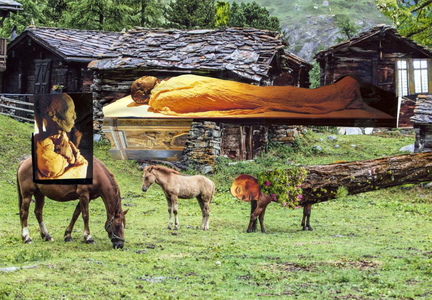
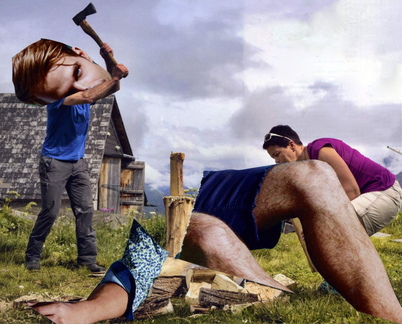


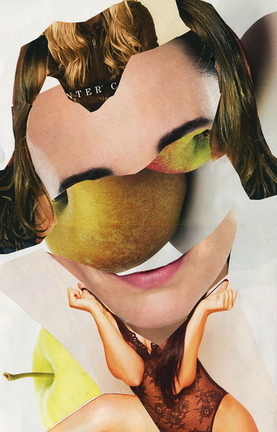

You must be logged in to see the comments. Log in now!